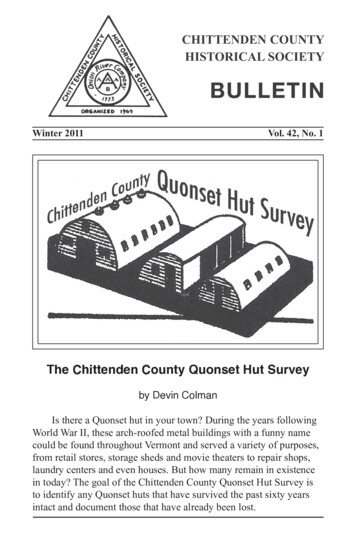
Transcription
Winter 2011Vol. 42, No. 1The Chittenden County Quonset Hut Surveyby Devin ColmanIs there a Quonset hut in your town? During the years followingWorld War II, these arch-roofed metal buildings with a funny namecould be found throughout Vermont and served a variety of purposes,from retail stores, storage sheds and movie theaters to repair shops,laundry centers and even houses. But how many remain in existencein today? The goal of the Chittenden County Quonset Hut Survey isto identify any Quonset huts that have survived the past sixty yearsintact and document those that have already been lost.
Origins of the Quonset HutDesigned in 1941 for the United States Navy and named forthe Naval Air Station on Quonset Point, RI, where they were firstmanufactured, the Quonset hut is an icon of World War II buildingtechnology. Needing a lightweight, portable structure that could beassembled and disassembled quickly by untrained workers, the Navycommissioned the George A. FullerCompany to design and manufacturesuch a building. The Navy specifiedthat it had to be arch shaped, in orderto deflect shell fragments in combatzones. Given only sixty days tofinalize their plans, a team of FullerCo. engineers, led by architect OttoBrandenberger, found inspirationin the Nissen hut. Developed andmanufactured by the British for useduring World War I, the Nissen hutwas a semi-circular prefabricatedmetal building to which the Quonsethut bears a striking resemblance.Functionally, however, the Nissen hutleft much to be desired: it was difficultto erect, required numerous partsand tools for assembly and lackedinsulation.By using standardized components thatcould be put together with commontools and adding a layer of insulationbetween the interior and exterior wallpanels, the Quonset hut became afully functional building that could beshipped anywhere in the world anderected by a team of ten men in justone day. The Navy’s need for such abuilding was so great that the Quonsethut was put into production before thefinal plans had even been approved.CCHS Bulletin Page 2
Quonset Hut DesignThe basic structure of the Quonset hut is straightforward:rounded steel-frame structural members support an exterior skin ofcorrugated sheet metal, a layer of insulation, and an interior skin ofpressed wood. The two open ends are enclosed with plywood panels,into which doors and windows are easily installed. Adding to theQuonset hut’s versatility, it could be erected on a poured foundation,pilings, or directly on the ground. Floors were often finished withlarge sheets of plywood. Some huts included dormer windows alongtheir sides, especially if they were to be used for housing.The first huts measured 16 feet wide and 20 or 36 feet long. Alater version of the huts included low sidewalls to increase the usableinterior floor space, rooftop ventilators and various window anddoor configurations. The Navy manufactured an estimated 150,000Quonset huts during World War II. After the war, many of the hutswere disassembled, shipped back to the United States, and sold to thepublic for 1,000.00 each. How many of these surplus huts made theirway to Vermont?UVM Quonset HutOne surviving example is the Quonset hut located at theUniversity of Vermont, behind Dewey Hall (the former MedicalBuilding) at the corner of Colchester Avenue and North ProspectStreet. Now used by the UVM Geology Department as long-termstorage space, this Quonset hut was erected c. 1947 to houseresearch animals used in medical experiments.i In 1948, R. M.Peardon “Pete” Donaghy, MD, chair of neurosurgery at UVM,conducted his first research into peripheral nerve repair in the UVMQuonset hut.ii The hut is an example of a Stran-Steel Quonset hut,representing the third and final evolution of the original Quonsethut design. In 1943, production at Quonset Point ceased and wastransferred to the Stran-Steel Division of the Great Lakes SteelCorporation. On a Stran-Steel Quonset hut, the exterior corrugatedmetal siding is installed horizontally, while factory-curved panelsform the ridgeline to shed water. These huts were also larger,measuring 20 feet wide by 48 or 56 long.CCHS Bulletin Page 3
About the SurveyThe Chittenden County Quonset Hut Survey is an informalinventory of the remaining Quonset huts in Chittenden County.Locating and identifying Quonset huts today can be difficult, primarilybecause they were frequently utilized as outbuildings and erectedbehind other structures, in rural areas, and out of view from the generalpublic. Several known examples in Burlington that were highly visiblehave been demolished and replaced with newer buildings. These “lostQuonset huts” will be described in future issues of the CCHS Bulletin.In the meantime, if you know of a Quonset hut in your town, knowwhere one used to be, or remember living or working in one, pleasecontact Devin Colman at devincolman@mac.com or 802-655-0502.The results of the survey will be compiled and reported in January2012. For more information about twentieth-century architecturethroughout Vermont, please visit www.vermontmodern.com.1For detailed information on Quonset huts, please refer to the book QuonsetHut: Metal Living for a Modern Age, by Chris Chiei and Julie Decker, publishedby the Princeton Architectural Press, 2005.2The UVM Quonset hut is shown on the 1942 Sanborn Fire Insurance Map aspart of an update in June 1950.3James C. Hebert, MD, FACS, The History of Surgery in Vermont, http://www.med.uvm.edu/surgery/TB1 BL.asp?SiteAreaID 520.CCHS Bulletin Page 4
The Quaker Smith Point Water Silo:An Example of Adaptive ReusebyMichael RichardsThe conservation of historic resources has become an intricatescience that employs a variety of professions, including architecture,history, engineering, and fine carpentry. Appropriate treatments mustbe determined based on a resource’s physical condition, historicalsignificance, proposed use, and any requirements necessary to bringthe resource up to current codes. In many cases, historic resourcescan be adapted for entirely different functions than originallyintended without damaging their historic character.Although many adaptive reuse projects make headlines innewspapers and architecture periodicals, transformations that occurin our communities often go unnoticed. This article describes aninnovative adaptive reuse project, the rebuilding of a water silo atQuaker Smith Point in Shelburne, Vermont.Quaker Smith PointQuaker Smith Point is a teardrop-shaped peninsula thatextends westward into Lake Champlain from the southwestshoreline of Shelburne Farms. The point was first settled byblacksmith William “Quaker” Smith and his wife Elizabeth in1783. The Smiths lived and farmed off the land at Quaker SmithPoint, as it came to be known, and constructed a house and farmbarns for animals and agricultural storage. The property washanded down to William and Elizabeth’s grandson Isaac around1792. When Isaac died in 1870, his wife initially leased the farm.It became part of the Shelburne Farms estate when Seward andLila Webb purchased the property in 1886.According to Shelburne Farms historian Erica Huyler Donnis,“Seward and Lila’s eldest son, Watson Webb, was officially deededQuaker Smith Point in 1913 when he chose Southern Acres ashis portion of the outlying properties that Seward and Lila weredividing among their four children. Watson expanded the propertyby constructing a new silo for water storage, a new sheep fold,extensions to the existing barns, and a new house for employeesCCHS Bulletin Page 5
and guests. In 1935, Watson and Electra Webb gave their eldestson Sam use of the farmhouse. Sam also made several additionsto the property, including a trophy house to showcase catchesfrom his hunting voyages. Sam was then officially deeded theproperty in 1949” (The History of Shelburne Farms: A ChangingLandscape, An Evolving Vision, p. 198).After Sam passed away in 1988, the property was splitbetween his two children, Holly Webb Darling Froud and SamWebb Jr. They eventually made the difficult decision to divide andsell the property to private owners. Jon Fishman, the drummer ofthe band Phish, purchased the 18-acre northern parcel of the pointin the spring of 2004 and lived in what was once the employee/guest house constructed by Watson Webb. Michael and KarenStone purchased the southernmost parcel comprising 15.7 acres in2004, and eventually purchased Fishman’s parcel in 2005.The Stones have made some remarkable changes and additionsto the property’s buildings and landscaping that have upgraded thesite while still preserving the original colonial aesthetic imprintedby the Smiths and Webbs. In 2004, the Stones hired Vermontbuilder Peter Close to disassemble and reconstruct the water silo.The SiloCylindrical tower silos used for bulk storage have beenconstructed from wood, steel, rolled steel shells, concrete/stone/brick block, or concrete staves. In the late nineteenth and earlytwentieth centuries, concrete stave silos were the most commondue to ease of construction and concrete’s strong compressivestrength suitable for storing tightly packed material. The stavesare small concrete blocks pieced together by tongue and groovejoints and tightly wound by a steel hoop system to furthercompress the silo to prevent structural failure. Silos with woodenstaves, like the one at Quaker Smith Point, were also oftenwound by steel hoops. The circular design of silos makes for aninteresting space that can be adapted to a variety of functions.The simple construction also allows relatively rapid disassemblyand reassembly that enables silos to be moved to and fromdifferent sites, an attribute that benefits both agricultural needsand adaptive reuse projects.CCHS Bulletin Page 6
Photographs on the following pages illustrate thedeconstruction-reconstruction process of the Quaker Point watersilo. The renovated silo is about 22 feet in diameter, 30 feet inheight, and contains about 760 square feet of interior space. Thereconstruction features a stronger, light wood frame, red hand-splitcedar shake siding, double-hung windows, and a conical metalroof. The water cistern now sits below the silo and still functions todistribute water via the well across the property. A yoga studio anda meditation room occupy the ground and upper levels, respectively.Windows strategically placed around the circumference of the silomaximize natural light and provide breathtaking 360-degree vistasthat showcase the rolling countryside and Green Mountains to theeast and the glistening water of Lake Champlain and the AdirondackMountains to the west. Much of the original exterior cedar woodwas reused for finishes on the interior walls and other lumber wasrecycled for the spiral staircase. The silo is naturally cooled by thegentle breezes of Lake Champlain in the summer and can be heatedin the winter by propane.Original silo showing water cistern inside. Courtesy of Peter Close.CCHS Bulletin Page 7
Cistern being disassembled and moved. Courtesy of Peter Close.New structural framing. Courtesy of Peter Close.CCHS Bulletin Page 8
View of entrance on south facade.Second level meditation space finished with the old exterior boards.CCHS Bulletin Page 9
The Quaker Point silo project demonstrates how wellcomponents from older structures can be recycled. More importantly,it preserves a remnant of our cultural and historical heritage anddemonstrates the potential splendor of adaptive reuse. Yesterday’shistorical vestiges can become tomorrow’s active spaces, spaces thatcan both preserve the stories of the past while providing new life forthe present and the future.Acknowledgements. The author would like to extend very special thanks to Michael andKaren Stone for providing access to their beautiful property and giving him information on thesilo at Quaker Smith Point. Builder Peter Close provided an array of images documenting theconstruction process of the silo.Vermont Barn Census:Chittenden County BarnsIn 2009 and 2010, local volunteers and graduate students enrolledin the Researching Historic Structures and Sites course in theUniversity of Vermont Historic Preservation Program conducteda barn census and undertook historical research about farmingin Chittenden County. The information they collected about theagricultural heritage of Chittenden County towns is available at:http://www.uvm.edu/ hp206/2010CCHS Bulletin Page 10
Vermont Civil War SesquicentennialCivil War Places in Chittenden CountyThe Vermont Humanities has initiated a project toidentify Civil War sites where Vermonters “mobilized,worked, argued, worried, and mourned,” including “thechurches where abolitionists lectured, the factories thatmade guns and uniforms, the farms run by women andchildren in the absence of men, and the monuments,GAR halls, and cemeteries throughout the state.”The Council invites all Vermonters to locate sites, conductresearch, and share stories. The Council has created a research kit andtemplates for walking tours and brochures. The research kit includeshelpful information on people, places and themes to look for; sources intowns, around the state, and on the web; a step-by-step guide to findinga Civil War place; a bibliography; and a list of Civil War Places to visit.For more information, consult the Civil War Places Research Kit onlineat http://www.vermonthumanities.org/Civil War Research kit.pdf.Two Civil War Places projects for Chittenden County have alreadybeen completed. Julia Lewandowski, the Civil War program assistantat the Vermont Humanities Council, designed a “Civil War PlacesWalking Tour” for Burlington based on research by Howard Coffin.The self-guided walking tour extends from the Old North End throughdowntown and into the South End. It includes sixteen Civil War placesand takes about two hours. Lewandowski is also the author of “FindingRichmond’s Civil War Sites.” She shares the results of her efforts tofind out about the men from Richmond who went to war, events inRichmond during the war, and stories and places that make the town’sCivil War history come to life. Download the Burlington tour at http://www.vermonthumanities.org/index files/Civil War Walking Tour.pdf. Readabout Richmond’s Civil War sites at http://www.vermonthumanities.org/index files/Civil War Research in Richmond.pdf.CCHS Bulletin Page 11
The Soldiers’ Monument erected in Burlington’s CityHall Park in 1907. The plaque reads, “In honor of thebrave men who victoriously defended the Union onland and sea during the War of the Great Rebellion.”CCHS Bulletin Page 12
2010 Research GrantsThe CCHS awarded five research grants in 2010 to supportprojects on a variety of topics and places.Schuyler Jackson of Hinesburg received a grant to support hisresearch on the advent of electric power in Chittenden County andits impact on the culture, society, economy, and land use within thecounty. He plans to interview residents who remember the transition toelectricity and review historical documents.Judy Rosenstreich will develop a guidebook to the historic Jewishcommunity in Burlington’s Old North End. The guidebook willincorporate photographs, interviews with descendants of the originalimmigrants, and commentary on the religious, economic and culturalcontributions of this community to the city, county and state.Michael R. Gadue will write a history of the Vermont ArmyNational Guard Mountain Warfare School in Jericho that willillustrate the tradition of living and working in mountain andnatural environments.Sylvia Allen received an award to support her comprehensivehistory of the Vermont Transit Company and a biography of its founder,William S. Appleyard. Vermont Transit services changed the face oftransportation in Chittenden County and opened up opportunities formany of the county’s residents.Emily Morgan will conduct a survey of historic structuresin the Chamberlain District and Mayfair Park neighborhoods ofSouth Burlington. Her research, including oral histories fromlong-time residents, will document Chittenden County’s evolutionfrom rural to urban and present a history of architectural styles inthe two neighborhoods.Each year, CCHS awards research grants to individuals who proposeoriginal research projects about Chittenden County’s past. Visit theCCHS web site to find an application.CCHS Bulletin Page 13
New Titles on the Book ShelfShelburne Museum’s CircusCollection. Kory Rogers. Shelburne,VT: Shelburne Museum, 2010.Shelburne Museum curatorRogers packs the 62-pagepaperback with coloredillustrations of the museum’scircus collection. It includesreproductions of nineteenth and twentieth-century posters advertisingcircus spectacles, aerialists, thrill acts, sideshow freaks, and more.Bulletin readers will be especially interested in the section on posterscarefully recovered from the exterior of a Colchester, VT house.The 525-foot long miniature circus parade and the 3,500 handcarvedpieces of the Kirk Bros. Circus, favorites of generations of museumvisitors, are also featured.Burlington International Airport:A History 1920-2010. James Tabor,foreword by Brian Searles. BurlingtonInternational Airport, 2010.As Brian Searles, Burlington Airport’sformer Director of Aviation says in theforeword, this is a “wonderful volumeabout the personalities, politics andadventure that took this airport from100 acres with a grass strip in 1920to the busy facility used by nearly1.5 million commercial passengers, thousands of general aviationpilots and countless military operations each year.” In elevenchapters, author James Tabor takes the reader from the early daysof “Wings and Prayers” to the 2010 document designed to guidethe airport’s development through 2030. The hardcover, 190page book contains 117 black and white historical photos and 25spectacular color images.CCHS Bulletin Page 14
CHITTENDEN COUNTY HISTORICAL SOCIETYP. O. Box 1576Burlington, Vermont 05402-1576cchsvt@gmail.comCCHS BoardAnn ArmsSylvia BugbeeCarol Casey, Vice PresidentPrudence DohertySarah DoppLeo Fleury, TreasurerSarah Gustafson, SecretaryElise Guyette, PresidentSylvia Heininger-HoldenJeff HindesSandra LindbergLyn PerrinGail RosenbergKarin SchumannDorothy Seale-BrownFor information about programs, contact:Elise Guyette at cchsvt@gmail.comTo become a CCHS member, contact:Jeffrey Hindes at jhindes@cssu.org.For story ideas, suggestions and questionsabout the CCHS Bulletin, contact the editor at:cchsvt@gmail.com.CCHS Bulletin Page 15
P.O Box 1576Burlington, Vt. 05402-1576Chittenden CountyHistorical SocietyBULLETINNon-ProfitOrganizationU.S. PostagePaidBurlington, VTPermit No. 100
1 For detailed information on Quonset huts, please refer to the book Quonset Hut: Metal Living for a Modern Age, by Chris Chiei and Julie Decker, published by the Princeton Architectural Press, 2005. 2 The UVM Quonset hut is shown on the 1942 Sanb











